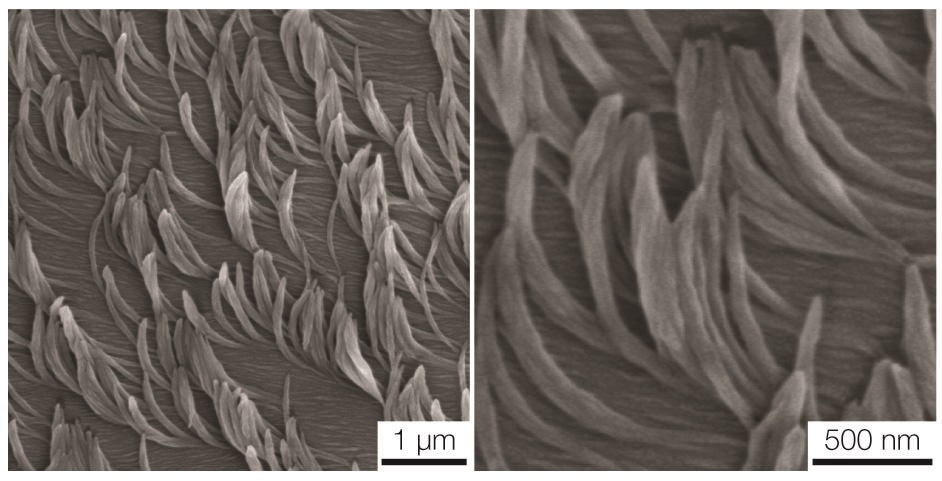Nov 16 2018
Taking a cue from the unique characteristics of gecko feet, polar bear fur, and lotus leaves, engineering researchers have now devised a novel method for making arrays of nanofibers that could result in the development of coatings that are repellent, sticky, light emitting, insulating, among many other possibilities. The study has been reported in journal Science.
 An electron microscope image of banana-shaped nanofibers templated with a liquid crystal. (Image credit: Kenneth Cheng, Lahann Lab, Michigan Engineering)
An electron microscope image of banana-shaped nanofibers templated with a liquid crystal. (Image credit: Kenneth Cheng, Lahann Lab, Michigan Engineering)
This is so removed from anything I’ve ever seen that I would have thought it was impossible.
Joerg Lahann, Professor of Chemical Engineering and Study Author, University of Michigan.
This slightly serendipitous discovery was made by researchers from the University of Michigan (U-M) and the University of Wisconsin, revealing a new, robust technique for making arrays of fibers that are many times thinner than that of a single strand of human hair.
The hairs of polar bear hairs are structured in such a way that they permit light and, at the same time, prevent heat from escaping. While arrays of tiny waxy tubules are coated on water-repelling lotus leaves, the bottoms of gravity-defying gecko feet have nanoscale hairs that reach very close to other surfaces, triggering atomic forces of attraction. Scientists looking to imitate these superpowers and more have required a means to develop the tiny arrays that do the job.
“Fundamentally, this is a completely different way of making nanofiber arrays,” said Lahann.
The scientists have demonstrated that their nanofibers were able to repel water-like lotus leaves. They accomplished this feat by growing curved and straight fibers and testing how they stuck together similar to Velcro, and eventually discovered that anticlockwise and clockwise twisted fibers knitted together more closely when compared to two arrays of straight fibers.
The researchers even experimented with optical properties and created a material that glowed. According to them, a structure can be made that works similar to the fur of a polar bear, with separate fibers structured to channel light.
However, the original plan was not to develop molecular carpets. Lahann’s team was working with the team of Nicholas Abbott, who was serving as a professor of chemical engineering at University of Wisconsin–Madison (UW-Madison) to place polymers—thin films of chain-like molecules—on top of liquid crystals. Liquid crystals are extensively used in computer screens, televisions, and other similar displays. The group was attempting to develop sensors that can identify single molecules.
While Abbott headed the design and development of the liquid crystals, Lahann brought the know-how of creating thin films. In standard experiments, Lahann’s team first evaporates single links in the chain and then allows them to condense onto surfaces; however, the thin polymer films at times did not materialize as anticipated.
The discovery reinforces my view that the best advances in science and engineering occur when things don’t go as planned. You just have to be alert and view failed experiments as opportunities.
Nicholas Abbott, Former Professor of Chemical Engineering, University of Wisconsin–Madison.
Rather than coating the top of the liquid crystal, the single links slipped into the fluid and linked with one another on the glass slide, and the liquid crystal subsequently directed the shapes of the nanofibers that grew up from the bottom and produced nanoscale carpets.
A liquid crystal is a relatively disordered fluid, yet it can template the formation of nanofibers with remarkably well-defined lengths and diameters.
Nicholas Abbott, Former Professor of Chemical Engineering, University of Wisconsin–Madison.
And they didn’t just create straight strands. Based on the liquid crystal, they could create curved fibers, like tiny staircases or bananas.
We have a lot of control over the chemistry, the type of fibers, the architecture of the fibers and how we deposit them. This really adds a lot of complexity to the way we can engineer surfaces now; not just with thin two-dimensional films but in three dimensions.
Joerg Lahann, Professor of Chemical Engineering and Study Author, University of Michigan.
The study is titled “Templated nanofiber synthesis via chemical vapor polymerization into liquid crystalline films.”
The Army Research Office supported the study.
Lahann is also director of the U-M Biointerfaces Institute and professor of materials science and engineering, biomedical engineering, and macromolecular science and engineering. Currently, Abbott is the Tisch University Professor and professor of chemical and biomolecular engineering at Cornell University.